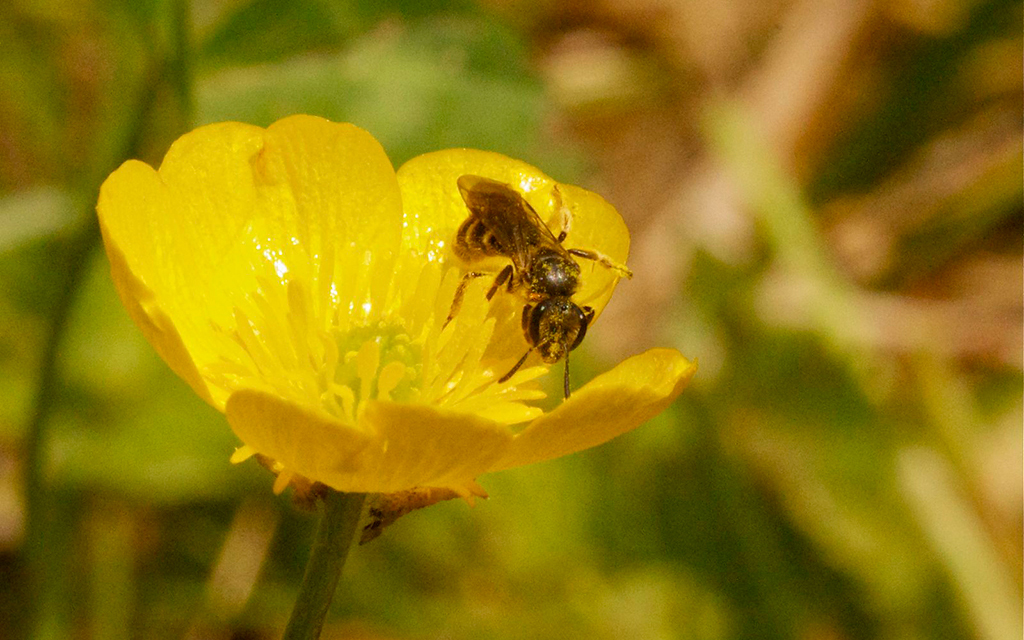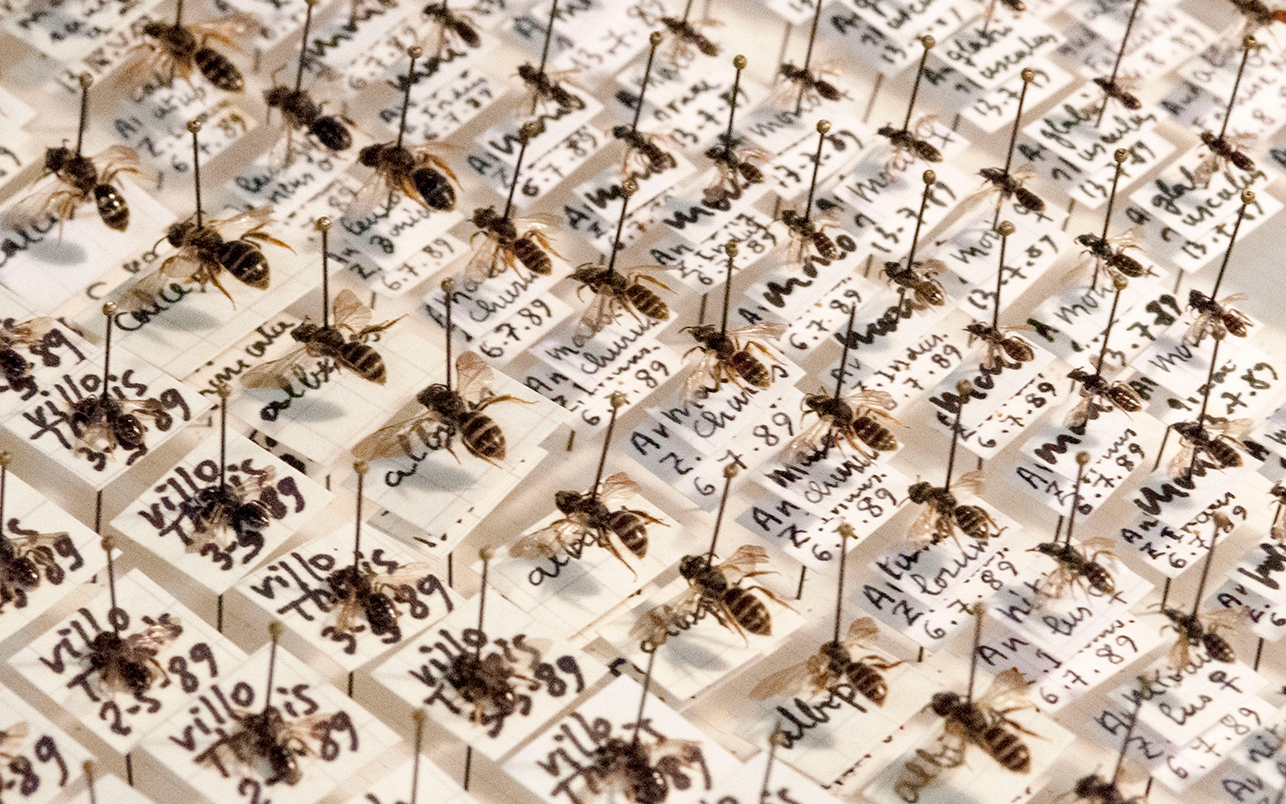In Bees, a Hunt for Roots of Social Behavior

Every few months, Sarah Kocher makes a pilgrimage to France. Butterfly net in tow, the Harvard biologist travels the countryside — from the fields of Provence to the mountainous regions near Switzerland and Germany — in search of bees. Her target is Lasioglossum albipes, an unusual species of the so-called sweat bee that is capable of two very different lifestyles. Depending on where and to whom they’re born, these bees live either largely alone, raising their own young, or as part of a commune, where tasks such as caring for the young and foraging for food are divvied up and all members reap the rewards.
Although honeybees are legendary for their complex cooperative societies, the vast majority of bee species are solitary creatures. Few can adopt either lifestyle, living alone or as part of a community as circumstances dictate. These species are particularly interesting because they represent an intermediate step in the progression from a solitary existence to a social one. “How did social insects evolve from solitary ancestors?” said Sandra Rehan, a biologist at the University of New Hampshire who studies a different bee with similar behavioral flexibility. “L. albipes is a nice way of looking at social evolution within a species.”
Among the bee varieties that can adopt either a social or solitary lifestyle, L. albipes is the only known species in which this choice has been shown to be genetically determined — they are born into their fates. This is what drew Kocher, who is interested in the genetic root of behavior, to the species. Comparing the genomes of the two varieties of L. albipes might reveal to Kocher what exactly in their genome makes them behave one way or the other.
“What does it take to make a social bee?” asked Gene Robinson, who is a biologist at the University of Illinois and collaborates with Kocher on another bee genome project.
So far, scientists have only hints of the answer to this question. Initial comparisons of solitary and social bees have found two major classes of genes that differ between the two groups; genes involved in metabolism, which may reflect the different foraging and energy needs of social insects, and genes that influence signaling between cells, which may be a sign of enhanced social communication. However, the key to the social genome might lie not only in different genes, but also in how those genes are controlled — when and where they are turned on and off during development.
Bee researchers say major insights are likely to come from an ongoing project, with a paper expected to be published later this year, comparing the genome sequence of 10 different species of bees. This will provide an unprecedented tool for exploring differences in how genes are regulated, which could shed light not only on the social life of bees, but also on social behavior in other animals, including humans.
Kocher’s sweat bee is one of the 10 and the first bee species since the honeybee to have its genome sequenced. After catching her specimens — solitary sweat bees mainly come from the cooler, mountainous regions of eastern France and their social brethren from the south and west — Kocher sent their DNA to be decoded at a massive sequencing facility in China known as BGI. Results from the first round of sequencing, published in December, have already pointed to some differences. For example, genes associated with metabolism are changing rapidly in L. albipes, a finding that echoes other studies of social bees.
“Metabolism keeps popping up over and over again as playing an important role in social behavior,” said Kocher, a postdoctoral researcher working with two Harvard biologists, Naomi Pierce and Hopi Hoekstra. Some metabolic processes, such as insulin signaling, appear to play a role in division of labor in bees. The new findings suggest that these same pathways may also play an important role in the evolution of social behavior in L. albipes. The researchers also found hints that social L. albipes’ sense of smell might distinguish them from solitary L. albipes, but the scientists caution that larger follow-up studies analyzing more bees are needed to confirm the finding.
Honeybees’ sophisticated societies rely on a strict division of labor. The queen lays eggs, some insects remain in the hive to raise the young, and others forage, traveling beyond the hive in search of pollen. This parceling of jobs is the defining feature of the most extreme form of social society, called eusociality or true sociality. (The prefix “eu” comes from the Greek word for “well” or “good.”) Nurse bees and foragers make the ultimate sacrifice for the hive, giving up their right to reproduce and instead feeding and caring for the young. In his book “The Social Conquest of Earth,” the biologist Edward O. Wilson described the evolution of eusociality as “one of the major innovations in the history of life,” likening it in impact to “the conquest of land by aquatic air-breathing animals” and “the invention of powered flight by insects and vertebrates.” Eusocial societies generate “super-organisms, the next level of biological complexity above that of organisms,” he wrote.
Among the menagerie of animal life, eusociality is rare. More than 90 percent of bees are solitary. “But eusocial species can have an outsize impact on the planet,” Robinson said. Honeybees are our most important pollinators, for example, and other eusocial species, such as termites and killer bees, are some of our biggest pests. “With their highly integrated colonies, they can achieve way more impact than individuals can,” Robinson said.
One of the qualities that make bees such good candidates for studying sociality is that unlike ants and termites, they have both social and solitary species. While the scores of social ant species all evolved from one common social ancestor, bees’ eusocial nature evolved multiple times independently. That means scientists can search for genetic commonalities among various social species and how they differ from their solitary cousins.
“Right now, we’re in the midst of a really interesting period of time, where evolutionary studies using genomic information are coming out more and more,” Robinson said.
As genetic technologies evolved, Robinson’s team sequenced the honeybee’s entire genome, as well as partial genomes of other bees. By comparing the different species’ proteins, they hope to find a genetic toolkit for social behavior, a collection of genetic changes that enable the sophisticated social structure of bee communities. If all the social species show changes in the same genes or genetic pathways, meaning genes involved in the same process, it will suggest that the different varieties of social bee settled on a common strategy for creating social behavior. Such toolkits have been identified for other biological features, such as eye development.

In 2006, the honeybee became the third insect to have its genome decoded, after mosquitoes and fruit flies. Compared to those non-social insects, honeybees have many more genes involved in smell, specifically the molecular receptors that recognize chemical pheromones. These chemicals play an essential role in social communication, such as how to distinguish strangers from nest mates and to detect the different social castes.
Robinson’s team then compared the partial genomes of 10 species of bees, both solitary and social. The findings, published in 2011, identified two general gene categories that appear to have evolved in all the social species — genes involved in carbohydrate metabolism and genes involved in communication between cells. Scientists don’t yet know exactly how these changes affected the insects. Regarding metabolism, Robinson speculates that social bees, which live in nests of hundreds to thousands of members, may have higher energy needs. They have to heat and cool their nests, for example, and they feed their young differently than their solitary counterparts. Loner bees leave a blob of pollen on the egg and wipe their hands of it, whereas social species dote on their larvae.
Changes in communication genes might hint at changes in social bees’ brains, Robinson said. Social bees probably need special neural circuits dedicated to recognizing their hive-mates and performing and interpreting their famous dances.
As a graduate student in the 1980s, Robinson spent weeks in the field gazing at hives, carefully charting the movement of each bee as it flew in and out. The bee he remembers best is Yellow 57, known by the number on her colored tag. While her sisters made one to three foraging excursions per hour, Yellow 57’s forays were much more frequent; she embarked on 10 trips per hour, each lasting only three minutes. Robinson discovered that rather than wandering from flower to flower in search of pollen like most forager bees, Yellow 57 was gathering water at a nearby creek. She was a highly specialized water forager, the most highly specialized bee ever recorded, Robinson said. The story of Yellow 57 would shape the young biologist’s career, inspiring him to figure out how honeybees make such precise career choices.
In the last 22 years, Robinson and others have made major progress in understanding how genetics influence this division of labor. Forager bees have a different pattern of active genes in their brains, for example, than queens. And the transformation from nurse to forager is triggered by carefully orchestrated changes in gene activity, when and where genes are turned on or off.
From Worker to Queen
Queen and worker bees look and act differently, despite having the same or roughly the same genome. A process called methylation uses chemical markers to turn genes, or even whole chunks of chromosomes, off — which drives development of the queen bee. Honeybees, sweat bees, yellow jackets and wasps all use methylation to produce their queens. And simply silencing a gene involved in methylation can make a bee more queenlike.
Methylation may play a role in social behavior more broadly. Social insects, including ants, wasps and bees, have lots of these chemical markers, but non-social fruit flies don’t have any. “So far, it looks like a common strategy in each of these groups,” Evans said. Figuring out which genes are subject to these chemical markings could point the way to genes that are important for social behavior.
Robinson and others believe similar changes might underlie social behavior more broadly, acting on the entire species rather than the individual. If you imagine the activity of the whole genome as an orchestra, with each musician representing a single gene, the resulting performance depends not only on which instruments are included, such as flutes or horns. It also matters when they are played, how loudly, even how they are arranged. Changing any of these factors can create an entirely different composition. Similarly, changing when and where genes are switched on and off could result in different behaviors, such as division of labor. Previous research in other species, including humans, has shown that changes in gene activity can have a major impact on evolution.
To find changes in the parts of the genome that control gene activity, scientists need to examine the entire genome rather than only the part that produces proteins. (The protein-coding region, which is just a small fraction of the genome, was the focus of earlier studies.) Robinson launched a new project in 2010, to sequence the entire genome of 10 bee species, and his team hopes it will provide the genetic equivalent to the sheet music that directs the orchestra.
For the study, Robinson’s team selected species from the two bee lineages that have evolved eusociality — the Apidae, which includes honeybees, and the Halictidae, which includes Kocher’s sweat bee, L. albipes. Both families of bees include solitary and social species, but the two lineages evolved their cooperative natures more than 50 million years apart. “The rationale is that by comparing species that are separated by evolutionary time, genes common between them are probably important for behavior,” Pierce said.

Honeybee species have the most complex forms of eusociality, living in societies of tens of thousands of individuals divided by a sophisticated caste system. By contrast, the Halictidae live in smaller societies with a much simpler division of labor. Most notably, this family contains the few bee species for which social behavior seems to be optional; the bees tend to be cooperative in warmer climates with longer seasons. (Kocher’s species, L. albipes, is the only known halictid whose lifestyle has been shown to be genetically encoded. For others, the choice is influenced by environmental factors.)
“Halictidae are somehow closer to the ‘tipping point’ — the transition from solitary to eusocial,” Robinson said. “Being poised at the tipping point makes them compelling for evolutionary questions about the flexibility of the origins of eusociality.”
Researchers haven’t yet released results from the comparison of various halictid and honeybee species. But Kocher’s draft of the L. albipes genome — the first halictid to be sequenced — is giving some hints into what they might find. Roughly 8,000 of its 13,000 genes have counterparts in other insects or other species, giving scientists some insight into their function. But the remainder is something of a mystery. Two thousand of those genes are unique to the broader halictid family. Many of those have components linked to cell signaling, but scientists don’t yet know the genes’ function because they have no known counterparts in other organisms. Comparing the L. albipes genome with other insects, the researchers found that the bees seem to have more genes in gene families associated with insulin signaling and detoxification, suggesting these processes may be important in this species.
The real insight may come from comparing social and solitary varieties of L. albipes. Looking for genetic changes within the single species is a more fine-tuned approach than looking across different species, Pierce said. Because social behavior is the major difference between the specimens, whatever genetic differences are discovered are probably linked to social behavior rather than some other factor, like body shape. “It will help us identify genes of interest, and then we can look at the broader picture,” Pierce said.
So far, Kocher and her collaborators have sequenced only one solitary and one social bee, making it difficult to draw definitive conclusions. But they have some possibilities. The social and solitary L. albipes show differences in odorant receptors, which detect specific smells, suggesting an essential role for this system in social behavior. “There’s a real premium in social insects in figuring out who is part of your colony,” said Jay Evans, an entomologist with the U.S. Department of Agriculture who was not involved in the study. “Part of being social is the ability to recognize nest mates or intruders.”
In addition to olfactory genes, candidates for social genes include brain-linked genes that help neurons grow in the right place and break down specific brain chemicals.
Scientists say that the new resources — the L. albipes genome, Robinson’s 10 genomes and additional bee genomes from other ongoing projects — will provide even greater insight into the genetics of social behavior. Although bees may have surpassed us in social sophistication, they may still have something to teach us about our own behavior. “Bees are social behavior extremists,” Robinson said. “And in biology, one often can learn general insights by looking at extremists.” In humans, for example, it’s been difficult to figure out how information about the environment, including the social environment, affects health and wellness, Robinson said. “Bees are excellent model systems to explore this.”
This article was reprinted on ScientificAmerican.com.



